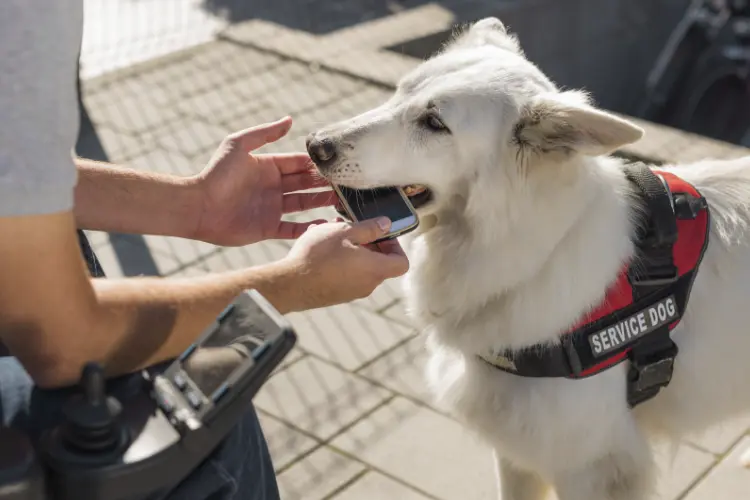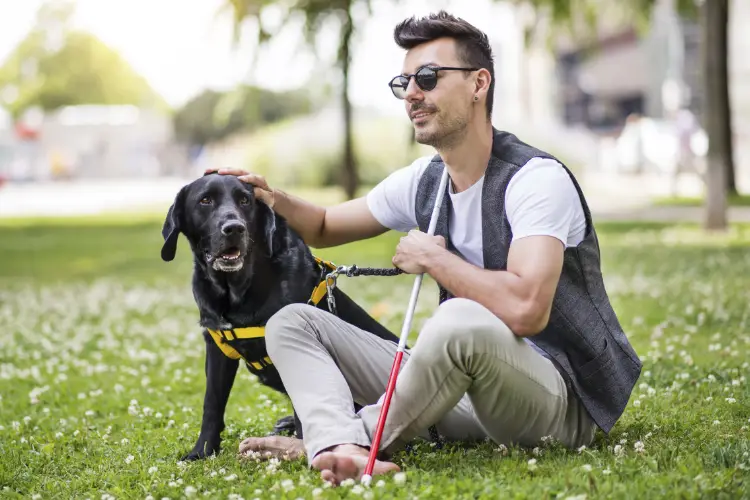Sometimes it’s not obvious what a service dog or psychiatric service dog does. The handler might have a disability that isn’t apparent just on visual inspection. Service dogs can perform over 150 distinct tasks for their handlers, benefiting both physical and psychological conditions.
ADA service dog laws require that a service dog be trained to perform specific tasks that directly relate to a person’s disability. The number of tasks that a service dog can perform is enormous, and we’ve tried to capture as many as possible in this list, broken down by the type of disability the task helps address. If you’re training a service dog to help you, you might find tasks that you didn’t even think of before that could help make your life easier.
Physical Disabilities
For people with mobility challenges, a service dog is the key to independence. When your body faces limitations, a service dog becomes an extension of yourself, reaching what you can’t reach, steadying you when balance fails, and offering the quiet dignity of doing things on your own terms. They transform “I can’t” into “we can.”
Mobility Support Tasks
Reach and Retrieve
- Picking up dropped items (phones, keys, medication bottles)
- Fetching specific objects on command (remote controls, reading glasses)
- Retrieving medical equipment like crutches, walkers, or wheelchairs
- Bringing items from other rooms
- Retrieving items that have rolled under furniture
- Bringing items to a specific person during emergencies
Door-to-Door Service
- Opening and closing doors with handles or automatic buttons
- Operating light switches and dimmer switches
- Pushing elevator buttons and selecting floors
- Activating automatic door openers
- Opening cabinets and drawers
- Operating electronic devices with buttons
Balance and Stability
- Providing counterbalance while walking
- Steadying handlers on stairs or uneven surfaces
- Assisting with transfers (bed to wheelchair, car to chair)
- Supporting weight during standing or movement
- Counter-bracing during physical therapy exercises
- Helping maintain balance during vestibular episodes
- Providing momentum for standing up from seated positions
Heavy Lifting
- Pulling wheelchairs up ramps or across obstacles
- Carrying items in specially designed packs
- Supporting body weight during movement
- Helping with dressing and undressing
- Assisting with putting on and removing shoes
- Moving laundry baskets or other containers
Navigation
- Guiding through crowded spaces
- Clearing pathways by moving obstacles
- Positioning for optimal access in public spaces
- Navigating airport security lines
- Leading to designated meeting points
- Helping navigate construction zones safely

Mental Health
Service dogs aren’t just physically capable—they’re emotionally intelligent too. Psychiatric service dogs are trained to recognize subtle changes in behavior, breathing, and body language that often precede mental health episodes.
Psychiatric Service Tasks
Crisis Intervention
- Interrupting panic attacks through deep pressure therapy
- Breaking up dissociative episodes by providing a grounding touch
- Alerting to rising anxiety levels before they peak
- Interrupting nightmares and night terrors with gentle waking
- Stopping self-harm behaviors or redirecting compulsive actions
- Performing room checks before entering to reduce hypervigilance
- Creating physical separation during confrontations
- Alerting to emotional escalation in others nearby
Medication Management
- Reminding handlers to take medications on schedule
- Retrieving pill bottles or emergency medications
- Bringing water for medication time
- Alerting others if medication is missed
- Detecting medication side effects through behavioral changes
- Carrying emergency psychiatric medications in special pouches
Public Space Navigation
- Creating physical barriers in crowded areas
- Finding exits during overwhelming situations
- Leading handlers to safe, quiet spaces
- Performing room searches to increase feelings of security
- Watching the handler’s back in public spaces
- Finding empty bathroom stalls for privacy
- Leading away from triggering environments
- Creating space at checkout lines or crowded events
Emotional Regulation Assistance
- Providing tactile stimulation during emotional spirals
- Offering deep pressure therapy for anxiety relief
- Interrupting repetitive or harmful thought patterns
- Providing a constant, calming presence during therapy sessions
- Performing specific calming rituals on command
- Alerting to sleep disturbances affecting mental health
- Performing “reality checks” during panic episodes
- Interrupting dissociation by bringing focus to the present
Sensory Disabilities
When one sense is compromised, service dogs become expert translators, converting sound waves and visual cues into actionable information.
Hearing Assistance Tasks
Sound Detection and Alert
- Recognizing doorbell chimes and knocks
- Alerting to phone rings and alarm clocks
- Responding to fire alarms and emergency signals
- Detecting cooking timers and appliance beeps
- Notifying about crying babies or calling voices
- Alerting to microwave completion signals
- Detecting washing machine/dryer cycle completion
- Recognizing car horns in parking areas
- Alerting to work/school bells or intercoms
Safety and Navigation
- Alerting to approaching vehicles
- Warning of sirens or emergency vehicles
- Leading to sound sources
- Providing earthquake or emergency wake-ups
- Detecting breaking glass or security alarms
- Alerting to unusual sounds that might indicate danger
- Recognizing weather alerts on the radio/TV
- Detecting smoke detector beeps during battery changes
Visual Impairment Assistance
Guide dogs are perhaps the most recognized service dogs, and for good reason—their training is incredibly sophisticated.
Obstacle Navigation
- Identifying and navigating around furniture, poles, and people
- Stopping at curbs, steps, and elevation changes
- Alerting to low-hanging branches or overhead obstacles
- Finding openings in crowds
- Detecting changes in ground texture (gravel to pavement)
- Navigating around parked bicycles and street furniture
- Avoiding moving obstacles like shopping carts
- Identifying safe walking paths in construction zones
Locating
- Locating doorways, elevators, and escalators
- Finding empty seats in public transportation or venues
- Identifying specific landmarks or buildings
- Locating bathrooms, counters, or information desks
- Finding specific stores in shopping centers
- Locating ticket machines or ATMs
- Finding specific gates at airports
- Finding designated waiting areas
Safety and Hazard Detection
- Stopping at traffic intersections
- Identifying moving vehicles or bicycles
- Detecting construction zones or dangerous areas
- Leading away from hazards
- Recognizing “walk/don’t walk” signals through trained routes
- Detecting water hazards or holes
- Avoiding aggressive dogs or animals
- Identifying safe drop-off zones for rideshare/taxi pickups

Neurological and Developmental Conditions
For autistic individuals and those who have seizures or other neurological conditions, service dogs provide predictability and reassurance.
Autism Assistance Tasks
Behavioral Intervention
- Interrupting repetitive behaviors like hand-flapping or rocking
- Redirecting attention during sensory overload
- Preventing elopement (wandering) by physically blocking or alerting
- Interrupting meltdowns with deep pressure therapy
- Alerting to rising stress levels before behavioral outbursts
- Interrupting aggressive behaviors toward others
- Responding to specific verbal or behavioral cues from family members
- Breaking up tantrums with distraction techniques
Social and Communication
- Offering comfort during routine changes
- Creating a calming presence in overwhelming environments
- Helping with focus during learning activities
- Facilitating interactions with strangers (ice-breaker effect)
- Providing non-verbal communication support
- Helping with transitions between activities
- Reducing social anxiety in group settings
Safety and Tracking
- Using GPS tracking systems for handlers who wander
- Staying close during outings
- Leading handlers away from dangerous situations
- Providing a consistent routine and stability
- Blocking access to dangerous areas (stairs, pools, roads)
- Alerting parents/caregivers when a child attempts to leave safe areas
- Tethering to prevent wandering during sleep
- Recognizing and avoiding overstimulating environments
Seizure Response and Alert Tasks
If you’re living with epilepsy or seizure disorders, the unpredictability can be one of the most challenging aspects. Seizure response dogs provide not just physical assistance, but something equally valuable—peace of mind. They become vigilant guardians during your most vulnerable moments.
Seizure Response
- Staying with the handler during seizure activity
- Activating emergency response systems
- Clearing dangerous objects from the area
- Positioning the handler safely to prevent injury
- Retrieving phones or medication post-seizure
- Providing physical support during post-ictal confusion
- Preventing injury from falling by cushioning the fall
- Maintaining airway positioning when possible
- Bringing comfort items after seizure recovery
Alert Capabilities
- Detecting pre-seizure changes in scent or behavior
- Alerting 15-45 minutes before seizure onset
- Leading the handler to a safe location before an episode
- Seeking help from family members
- Activating medical alert devices before seizures
- Bringing emergency medications proactively
- Creating physical barriers before public seizures
Medical Condition Early Warning System
Service dogs can be trained to detect specific medical changes, acting like a biological monitoring system.
Diabetes Alert Tasks
- Detecting high blood sugar (hyperglycemia) through scent
- Alerting to dangerous low blood sugar (hypoglycemia)
- Fetching blood glucose testing supplies
- Bringing juice boxes or glucose tablets
- Seeking help if the handler becomes unresponsive
Allergy Detection Tasks
- Sniffing out specific allergens like peanuts, tree nuts, or gluten
- Detecting dairy products, shellfish, or other food allergens
- Identifying airborne allergens in environments
- Checking surfaces for contamination
- Alerting before allergic reactions occur
- Retrieving emergency medications like EpiPens
Chronic Illness Support
For conditions like fibromyalgia, chronic fatigue syndrome, or Ehlers-Danlos syndrome, service dogs adapt to fluctuating symptoms.
- Providing stability during fatigue episodes
- Offering counter-balance for joint instability
- Carrying medical supplies and equipment
- Assisting with household tasks during flare-ups
- Alerting to changes in heart rate or blood pressure
- Providing deep pressure therapy for pain relief

Frequently Asked Questions About Service Dog Tasks
What’s the difference between a service dog task and just general helpfulness?
A service dog task must be specifically trained and directly related to mitigating a disability. For example, a dog that naturally comforts everyone when they’re sad isn’t performing a task; it’s simply being its natural self. But a dog trained to provide deep pressure therapy specifically for its handler’s panic attacks is a legitimate psychiatric service task.
Can one dog be trained for multiple disabilities?
Absolutely, and it happens more often than you’d think. Someone with PTSD and mobility issues might have a dog that performs both psychiatric tasks (like grounding during flashbacks) and physical tasks (like balance support). The key is that each task must be specifically trained and necessary for the handler’s disabilities.
Can I train my own dog to do these tasks instead of getting one from an organization?
Legally, yes — owner-training is completely valid under the ADA. But don’t underestimate how challenging it might be. You’re not just teaching tricks; you’re building a working partner who needs to perform reliably in all environments. Training a service dog on your own is completely doable, but don’t be afraid to ask for professional help if you need it.
How specific do these tasks need to be?
Very specific. “Make me feel better” isn’t a task; “Perform tactile grounding by nudging my hands repeatedly during dissociative episodes” is. The more specific and measurable, the better.






Leave a Comment